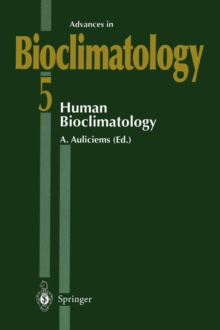
Advances in Bioclimatology 1 Paperback / softback
by R.L. Desjardins, R.M. Gifford, T. Nilson, E.A.N. Greenwood
Part of the Advances in Bioclimatology series
Paperback / softback
Description
Atmospheric carbon dioxide concentration has increased globally from about 280 ppm before the Industrial Revolution (Pearman 1988) to about 353 ppm in 1990.
That increase, and the continuing increase at a rate of about 1.5 ppm per annum, owing mainly to fossil fuel burning, is likely to cause change in climate, in primary productivity of terrestrial vegetation (managed and unmanaged), and in the degree of net sequestration of atmospheric CO into organic form.
The quantitative role 2 of the latter in attenuating the increase in atmospheric CO concentration itself is 2 an important but uncertain element of the global carbon-cycle models that are required to predict future increases of atmospheric CO concentration. 2 In my experience in workshops and other multidisciplinary gatherings, argument arises in discussion of this topic among different groups of scientists such as bioclimatologists, plant physiologists, biogeochemists and ecologists.
Plant concentration physiologists are often impressed by the positive effect of higher CO 2 on plant growth under experimental controlled environments and argue that this would be at least partly expressed in the field for many species and communities.
Information
-
Item not Available
- Format:Paperback / softback
- Pages:157 pages, X, 157 p.
- Publisher:Springer-Verlag Berlin and Heidelberg GmbH & Co. K
- Publication Date:21/11/2012
- Category:
- ISBN:9783642634819
Other Formats
- PDF from £38.24
- Hardback from £72.00
Information
-
Item not Available
- Format:Paperback / softback
- Pages:157 pages, X, 157 p.
- Publisher:Springer-Verlag Berlin and Heidelberg GmbH & Co. K
- Publication Date:21/11/2012
- Category:
- ISBN:9783642634819










